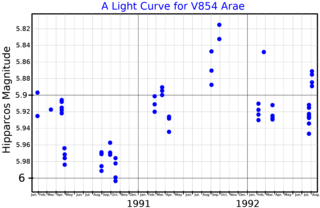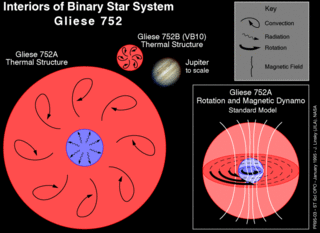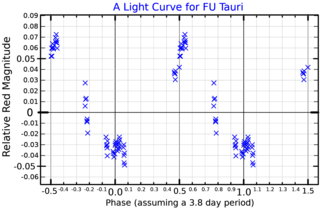Gliese 674(GJ 674) is a small red dwarf star with an exoplanetary companion in the southern constellation of Ara. It is too faint to be visible to the naked eye, having an apparent visual magnitude of 9.38 and an absolute magnitude of 11.09. The system is located at a distance of 14.8 light-years from the Sun based on parallax measurements, but is drifting closer with a radial velocity of −2.9 km/s. It is a candidate member of the 200 million year old Castor stream of co-moving stars.

28 Andromedae is a Delta Scuti variable star in the constellation Andromeda. 28 Andromedae is the Flamsteed designation. It also bears the variable star name GN Andromedae. Its apparent magnitude is 5.214, varying by less than 0.1 magnitudes.

9 Aurigae is a star system in Auriga (constellation). It has an apparent magnitude of about 5, making it visible to the naked eye in many suburban skies. Parallax estimates made by the Hipparcos spacecraft put it at about 85.7 light-years from the solar system.

Gliese 105 is a triple star system in the constellation of Cetus. It is located relatively near the Sun at a distance of 23.6 light-years. Despite this, even the brightest component is barely visible with the unaided eye (see Bortle scale). No planets have yet been detected around any of the stars in this system.

Zeta Cephei is a star in the constellation of Cepheus. Zeta Cephei marks the left shoulder of Cepheus, the King of Joppa (Ethiopia). It is one of the fundamental stars of the MK spectral sequence, defined as type K1.5 Ib.
Gliese 412 is a pair of stars that share a common proper motion through space and are thought to form a binary star system. The pair have an angular separation of 31.4″ at a position angle of 126.1°. They are located 15.8 light-years distant from the Sun in the constellation Ursa Major. Both components are relatively dim red dwarf stars.

V385 Andromedae is a variable star in the constellation Andromeda, about 360 parsecs (1,200 ly) away. It is a red giant over a hundred times larger than the sun. It has an apparent magnitude around 6.4, just about visible to the naked eye in ideal conditions.

HD 155035 is the Henry Draper Catalogue designation for a star in the constellation Ara, the Altar. It is located at a distance of approximately 1,450 light-years from Earth and has an apparent visual magnitude of 5.92, making it is faintly visible to the naked eye. This is a red giant star with a stellar classification of M1.5 III. It an irregular variable that changes brightness over an amplitude range of 0.12 magnitudes.

HD 135530 is a suspected variable star in the northern constellation of Boötes.

Gliese 752 is a binary star system in the Aquila constellation. This system is relatively nearby, at a distance of about 19 light years.

R Equulei is a class M Mira variable star in the constellation Equuleus. Its brightness varies between a minimum magnitude of 15.0 to a maximum of 8.7 with an average period of 261 days.

Sigma Ophiuchi, Latinized from σ Ophiuchi, is a single, orange-hued star in the equatorial constellation Ophiuchus. Its apparent visual magnitude is 4.31, which is bright enough to be faintly visible to the naked eye. The annual parallax shift of 3.62 mas as seen from Earth provides a distance estimate of roughly 900 light years. It is moving closer to the Sun with a radial velocity of −28 km/s.

V1073 Scorpii is a variable star in the constellation Scorpius. It has a non-Greek Bayer designation of k Scorpii. The star has a blue-white hue and is visible to the naked eye with an apparent visual magnitude that fluctuates around +4.87. Parallax measurements yield a distance estimate of approximately 2,920 ly (896 pc) from the Sun, and it is drifting further away with a radial velocity of +7 km/s. It has an absolute magnitude of −6.8
Gliese 3323 is a nearby single star located in the equatorial constellation Eridanus, about 0.4° to the northwest of the naked eye star Psi Eridani. It is invisible to the naked eye with an apparent visual magnitude 12.20. Parallax measurements give a distance estimate of 17.5 light years from the Sun. It is drifting further away with a radial velocity of +42.3 km/s. Roughly 104,000 years ago, the star is believed to have come to within 7.34 ± 0.16 light-years of the Solar System.
EQ Pegasi is a nearby binary system of two red dwarfs. Both components are flare stars, with spectral types of M4Ve and M6Ve respectively, and a current separation between the components of 5.8 arcseconds. The system is at a distance of 20.4 light-years, and is 950 million years old. The primary star is orbited by one known exoplanet.

Gliese 402 is a star located 22.7 light years from the Solar System. Located in the constellation of Leo, it is also known as Wolf 358 from its entry in Max Wolf's star catalogue. The stars nearest to Gliese 402 are Gliese 393, at 3.43 light years, Gliese 408, at 6.26 light years, and Gliese 382 at 6.66 light years.
Gliese 49 is a star in the northern constellation of Cassiopeia. Visually, it is located 106 arc minutes north of the bright star γ Cassiopeiae. With an apparent visual magnitude of 9.56, it is not observable with the naked eye. It is located, based on the reduction of parallax data of Gaia, 32.1 light-years away from the Solar System. The star is drifting closer to the Sun with a radial velocity of −6 km/s.

FU Tauri is a brown dwarf binary system in the constellation of Taurus about 429 light years away. The secondary is very close to the lower limit for brown dwarfs and several databases list it as a distant massive exoplanet.

Gliese 15 Ac is an exoplanet orbiting the nearby red dwarf star Gliese 15 A, which is part of a binary star system located about 11.6 light-years from the Sun. The planet was first proposed in October 2017 using radial velocity data from the CARMENES spectrograph, combined with measurements from the HARPS and HIRES spectrographs, and its existence was confirmed in April 2018 using HARPS-N data. It has a minimum mass 36 times that of Earth and orbits at around 5.4 astronomical units with a period of 7,600 days, an orbit which may have been sculpted by interaction with the companion star, Gliese 15 B. As of 2020, Gliese 15 Ac is the longest-period sub-Jovian planet discovered by radial velocity.

Gliese 569 is a ternary star system composed of a main-sequence star orbited by a pair of brown dwarfs in the constellation of Boötes about 32 light years away.
















